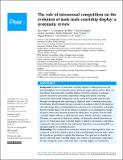The role of intrasexual competition on the evolution of male-male courtship display : a systematic review
Abstract
Background Evidence of male-male courtship display is widespread across the animal kingdom. Yet, its function and evolutionary origin remain unclear. Here, we hypothesise that male-male courtship display evolved in response to selection pressure exerted by intrasexual competition during male-female courtship interactions. Intrasexual competition can be caused by bystander male pressure through eavesdropping and exploiting on displayer male’s courtship interactions with females. This bystander pressure can lead to an audience effect by the displayer, who will change their courtship behaviour in the presence of bystanders and display directly towards them, even in the absence of females, as an intimidation strategy. In species where this selection pressure has taken place, we predict that the male courtship display will have a dual function: attract females and deter competitors. Therefore, we expected to find more evidence of bystander-related behaviours in species for which male-male courtship display is linked to intrasexual competition compared to species for which other explanatory hypotheses are more plausible (e.g., mistaken identity or courtship practice). Methodology We conducted two systematic reviews to test this hypothesis. First, we conducted a search for studies of species with courtship display between males and of the hypotheses provided to explain this behaviour. Our goal was to identify the species with male-male courtship display and evidence of intrasexual competition. Second, among the species with male-male courtship display, we searched for evidence of bystander-related behaviours, i.e., articles referring to eavesdropping, exploitation, and audience effect during male-female courtship interactions. Our goal was to test whether species with intrasexual competition are also more likely to show bystander-related behaviours. Results Although most studies reporting male courtship display towards other males do not suggest any explanatory hypothesis for this behaviour, the intrasexual competition hypothesis was largely mentioned and supported by some studies reviewed. Additionally, there is more evidence of eavesdropping and of all three bystander-related behaviours combined in species for which the intrasexual competition hypothesis was suggested. Conclusions Overall, our review supports the hypothesis that intrasexual competition can play a key role in male courtship display evolution, namely that male-male courtship display may have evolved as a secondary function of male-female courtship interactions via bystander male pressure. However, our review also shows that despite the increasing interest in same-sex sexual behaviours, and male-male courtship display in particular, most studies were found to be merely descriptive, and the hypotheses they suggested to explain courtship display between males mostly speculative. This highlights an important gap in the literature. To clarify both the evolution and the function of male-male courtship display, this behaviour needs to be empirically studied more often. Our review can help advancing this research area, as it makes the 20 species with male-male courtship display for which the intrasexual competition hypothesis was suggested excellent candidates for empirical research.
Citation
Órfão , I , Carvalho , C , Rodrigues , I , Ascensão , L , Pedaccini , M , Vicente , L , Borges Da Costa Guint Barbosa , M & Varela , S 2023 , ' The role of intrasexual competition on the evolution of male-male courtship display : a systematic review ' , PeerJ , vol. 10 , e14638 . https://doi.org/10.7717/peerj.14638
Publication
PeerJ
Status
Peer reviewed
ISSN
2167-8359Type
Journal article
Description
Funding: This work was supported by the Portuguese National Funds through FCT—Fundação para a Ciência e a Tecnologia, I.P., within: I&D units grants CFCUL—Centro de Filosofia das Ciências da Universidade de Lisboa (grant numbers FCT I.P.: UIDB/00678/2020 e UIDP/00678/2) and cE3c—Centre for Ecology, Evolution and Environmental Changes (grant number FCT I.P.: UID/BIA/00329/2013), and within Inês Órfão’s PhD grant (grant number SFRH/BD/90686/2012), and the Post-Doctoral research grants of Miguel Barbosa (grant number SFRH/BPD/82259/2011) and Susana AM Varela (grant number SFRH/BPD/66042/2009). Inês Órfão received financial support from ARDITI (M1420-09-5369-FSE-000002) and Miguel Barbosa received financial support from CESAM (UIDP/50017/2020þUIDB/50017/2020). This work was also supported by the European Research Council (ERC) within the project BioTIME (ERC grant number 250189).Collections
Items in the St Andrews Research Repository are protected by copyright, with all rights reserved, unless otherwise indicated.

